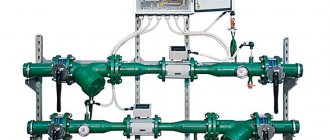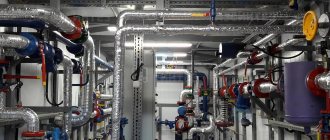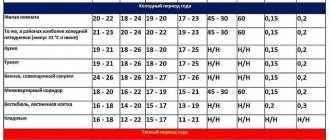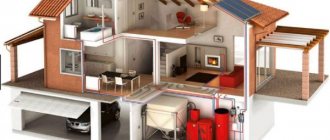Calculation of thermal energy production of a boiler house
To satisfy the various needs of consumers, there must be enough heat, which is provided by the boiler room.
Calculation of the thermal energy production of a boiler house shows how much fuel it will require and how much heat will be produced, which will then be used to ensure the operation of various engineering systems at the facilities. The results of such calculations must be economically justified. To understand how many fuel resources a boiler room needs to produce a given amount of energy, take into account:
- type of fuel;
- thermal power per hour (Gcal/hour);
- boiler efficiency;
- performance maps (according to performance testing), SNiP tables.
- heat load on DHW in one hour;
- daily system operation in hours;
- heating season time;
- own temperatures of unheated water in winter/summer.
If there are no ready-made regime maps, the efficiency of the boiler unit is calculated according to its condition, technical parameters, features and duration of operation. Calculations of fuel volumes are made in accordance with the instructions of the Ministry of Energy of the Russian Federation, which substantiates the standards for fuel supply to obtain the required amount of heat.
Fuel demand can be determined as follows:
Votp = Qotp * votp * 10-3
otp is the average fuel consumption rate, and Qotp is the volume of heat in Gcal that goes to the heating network.
Other methods for calculating heat volume
You can calculate the amount of heat entering the heating system in other ways. The formula for calculating heating in this case may differ slightly from the above and have two options:
- Q = ((V1 * (T1 - T2)) + (V1 - V2) * (T2 - T)) / 1000.
- Q = ((V2 * (T1 - T2)) + (V1 - V2) * (T1 - T)) / 1000.
All variable values in these formulas are the same as before. Based on this, we can say with confidence that the calculation of kilowatts of heating can be done on your own. However, do not forget about consultation with special organizations responsible for supplying heat to homes, since their principles and calculation system may be completely different and consist of a completely different set of measures.
Having decided to construct a so-called “warm floor” system in a private house, you need to be prepared for the fact that the procedure for calculating the volume of heat will be much more complicated, since in this case it is necessary to take into account not only the features of the heating circuit, but also provide for the parameters of the electrical network from which and the floor will be heated. At the same time, the organizations responsible for monitoring such installation work will be completely different. Many owners often face the problem of converting the required amount of kilocalories into kilowatts, which is due to the use of measuring units in the international system called “C” by many auxiliary aids. Here you need to remember that the coefficient converting kilocalories into kilowatts will be 850, that is, in simpler terms, 1 kW is 850 kcal. This calculation procedure is much simpler, since calculating the required volume of gigacalories is not difficult - the prefix “giga” means “million”, therefore, 1 gigacalorie is 1 million calories.
In order to avoid errors in calculations, it is important to remember that absolutely all modern heat meters have some error, but often within acceptable limits. The calculation of such an error can also be done independently, using the following formula: R = (V1 - V2) / (V1+V2) * 100, where R is the error of the common house heating meter, V1 and V2 are the water flow parameters already mentioned above in the system , and 100 is the coefficient responsible for converting the resulting value into a percentage.
In accordance with operational standards, the maximum permissible error may be 2%, but usually this figure in modern instruments does not exceed 1%.
Calculation of the volumes of thermal energy received
The amount of heat (Gcal) that is received from the boiler house during the year can be determined as the sum of indicators - energy received for different needs:
Qtotal year = Qyear1 + Qyear2 + Qyear3
This is the energy that needs to be generated in 12 reporting months for heating systems of objects (Qyear1), for ventilation systems (Qyear2) and for hot water supply (Qyear3).
Calculation of heat supply to a boiler room for domestic hot water is carried out taking into account the following parameters:
- heat load on DHW in one hour;
- daily system operation in hours;
- heating season time;
- own temperatures of unheated water in winter/summer.
The average monthly volume of heat (Gcal) supplied to the heating and ventilation system is calculated on the basis of the usual thermal load on such systems (Qо,вmax). A correction is made for the internal temperature, which is determined by the purpose of the object, and the average temperature of the month outside (according to SNiP 2.04.07-86). The formula also includes indicators of how many hours per day (Tsut) and how many days per month (nmonth) the boiler room operates.
Qav/month = Qo,vmax* (tin - tout av/month) / tin - tout) * Tout * nmonth
To determine what the thermal power of the boiler room is, the calculation is done in the following order:
- determination according to the energy generation plan;
- calculation of how much heat will be used to meet the technical and other needs of the boiler room itself.
At the same time, they take into account the shutdown of the boiler house in the summer months (various preventive maintenance, current or major repairs and preparation for the new heating season). Such activities are implemented according to pre-prepared special schedules, which are determined for different climatic areas.
Calculation of the thermal energy production of a boiler house in accordance with the standards in given periods is an event that ensures the necessary economic indicators and useful heat supply for all consumers. For such calculations, there are regulations and numerous formulas that professional designers use.
You can calculate the cost of a heating project using the calculator below:
Online design cost calculation
Option 3
We have one last option left, during which we will consider the situation when the house does not have a heat meter. The calculation, as in previous cases, will be carried out according to two categories (thermal energy consumption per apartment and ADN).
We will calculate the amount for heating using formulas No. 1 and No. 2 (rules on the procedure for calculating thermal energy, taking into account the readings of individual metering devices or according to established standards for residential premises in Gcal).
Calculation 1
Formula No. 1: 1.3 x 1,400 = 1,820 rubles, where:
- 1.3 Gcal – individual meter readings;
- 1,400 rub. – approved tariff.
Formula No. 2: 0.025 x 70 x 1,400 = 2,450 rubles, where:
- 0.025 Gcal – standard indicator of heat consumption per 1 m² of living space;
- 70 m² – total area of the apartment;
- 1,400 rub. – approved tariff.
As in the second option, the payment will depend on whether your home is equipped with an individual heat meter. Now it is necessary to find out the amount of heat energy that was spent on general house needs, and this must be done according to formula No. 15 (volume of services for one-room service) and No. 10 (amount for heating).
Example of a cottage heating project
Back
Forward
Ways to reduce consumption
The main reason for significant heat losses, which lead to ineffective consumption of the thermal energy released by the boiler unit, is insufficient insulation of the structural elements of the house. Up to 40% of heat is wasted through “cold bridges.”
Up to 35% of the heat generated by the boiler leaks through windows with poor-quality frames, up to 25% through the walls of the house, and up to 15% through the roof and entrance doors.
In order not to waste money every time heating the street, it is better to spend money once on high-quality thermal insulation of the building. Believe me, the costs for it will be fully recouped in 3-4 years.
Thermal insulation of a house includes:
- Insulation of walls. The easiest to implement and affordable option is the installation of polystyrene foam panels. The thickness of the panels is chosen based on the climatic conditions of the construction region, the thickness of the walls of the building and the type of material used in their construction.
- Insulation of the roof or attic floor. For these purposes, sawdust, mineral wool or polystyrene foam tiles are used. The heat-insulating material, produced in the form of slabs, is mounted on the internal walls of the attic space or placed between the floor beams.
- Insulation of floors. Not only concrete, but also wooden structures need good thermal insulation. To form a thermal insulating layer, bulk and slab materials such as expanded clay and expanded polystyrene are used.
- Replacement of windows. The most reliable shield that prevents the penetration of cold into heated rooms will be PVC windows with high-quality double-glazed windows. They are made for a specific window. Thanks to this, they hermetically close the window opening, reliably protecting household members not only from heat “leakage,” but also from the penetration of street noise.
Proper thermal insulation allows you to reduce heat loss to a minimum.
In addition to high-quality insulation, to increase the efficiency of heat transfer, experts recommend using other equally effective measures
Experts include additional measures to increase the efficiency of heat transfer:
- Equipment of radiators with thermostatic devices. Thermal heads will maintain the required comfortable temperature in the rooms.
- In addition to radiators, install convectors with directed circulation function. They will create thermal curtains from heated air in the area of the openings.
- Connecting equipment that allows you to program optimal heating modes. Installing chronometric thermostats is effective if there are rooms in the house that are empty for several days, which there is no point in intensively heating.
The costs of purchasing and installing automation will more than pay off within the first heating season.
And finally, it’s worth reconsidering whether the system is too loaded. It is possible that it produces excess heat. And it is likely that without compromising the comfort of household members, the indoor temperature can be reduced by a couple of degrees. At first glance - a trifle. But, considering the situation on the scale of at least one month, and even more so the heating season, such a decision can have a beneficial effect on the wallet.











